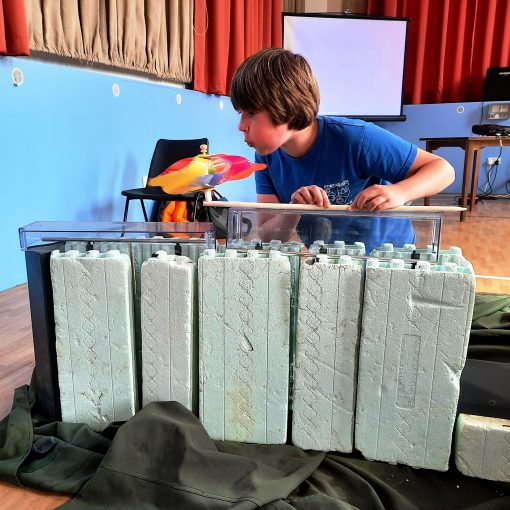24th JUNE 2022 – Opposites; little or large, commercial or charity, what’s the best approach for a Green Future project?
As every week revolves around to another Green Friday blog day, I feel the issues are becoming ever more complex and finding solutions that will suit everyone may be impossible. I am basing this opening observation on emails received about a big topic last time – motorist vs cyclist vs pedestrian … I don’t see how we will ever square this triangle (if you see what I mean). Bear in mind every one of these comes from a committed ‘Heart of Green’ reader.
Thank you to them for taking time to write; also to others who regularly send me links to info online.

1st email – … As you promote green living, I am confused by your sympathy with motorists. I can see from your article and interview with Lollypopper how bike lane interventions are increasing risk and hazards. This is inevitable as long as people obstinately refuse to relinquish their dependency on fossil fuel comforts and convenience. But I would argue that any transition period is tricky and reduction of car use along with other inconveniences like saving water (OMG what not take a shower every day!!!) or wearing winter woollies in the house, are adaptations we will have to make. I don’t believe that electrification of vehicles is the solution, it may be in part but I think wholesale EV production/ownership will push us much faster towards the climate ‘tipping point’ – if we are not there already.
2nd email – Just wanted to say how much I enjoyed reading your blog and thought your coverage of the situation regarding cars was very balanced. Calling the 4×4 a ‘big black monster’ did not suggest that you were uncritical of car drivers but at the same time, there are definitely some injustices and some very unsafe practices being introduced which affect motorists.
Regarding segregated bi-directional cycle lanes, they are generally safer for cyclists because, as common sense would suggest, they are kept apart from motor vehicles. However there are a couple of exceptions, i.e. points where cyclists are at more risk:
- When there are busy side roads, vehicle drivers do not reflexively look in the direction which is contra to the traffic flow as they pull out across the cycle lane, so accident rates are high
- Similarly if the lane is crossed by lots of pedestrians, they don’t look in the contra direction either, so you get more collisions involving cyclists and pedestrians
3rd email – Re Cycles and Lanes, I have also been fined for entering a bus lane by mistake in both Bristol and Oxford. On both occasions it was raining and I missed the road signs and markings.
My area of Cambridge and Cambridgeshire is very cycle-friendly, but the “lycra brigade” still ride on the congested A10 rather than the 1 million pound cycle path. You certainly need to keep your eyes open when crossing at corners on foot in the city. On one road the cycle lane is in the opposite direction to car traffic!
BALANCING ACT
So we see the truth, i.e. it is very tricky to achieve a balance that keeps people happy. At our Midsummer Open Event on Tuesday that was again an unmistakable theme: –
Wild vs Managed Historic vs New Human vs Animal Kingdom
each of these aspects was debated, with great passion and energy by the professionals, volunteers and life-long village residents. Let’s just consider them one by one.
Wild vs Managed
This has been very much on my mind, deciding how to get on top of a garden that is meant to be wildflower and wild creature-friendly, but not become total wilderness! Instead of my normal approach, using the solar-powered big mower to clean up the main lawn areas and having no time to think about the banks, edges and pathways, this time I chose to leave most of the lawns – as they are flowering and full of bees – in favour of a major tidy up around the sides. I like the result!
I note that some road hedges in the parish are being treated the same way, trim the sides and leave the top (in a haircut this would be called a short Mohawk!). Although it looks tidy I think this really shouldn’t be done on a roadside hedge in summer, where small creatures need to hide away. Indeed I saw a huge adder emerge from the base of a similar hedge that was untrimmed, on my morning run yesterday.



Wild vs managed was at the heart of discussions at the Tuesday conference, ref the future of our big river, locally. That’s the River Par in Luxulyan Valley, and it is a source of beautiful sounds and images, that I never tire of visiting.
The top priority of West Country Rivers Trust, though laudable for Nature Recovery, to me is alarming! Fish will be the winners over heritage and humans, if their vision comes about. The result visually will look incredibly messy and wild, trees felled into the water at regular intervals to gather leaves, debris and piles of gravel. Salmon, trout and eels will then have the best chances of migrating and spawning. Add in some otters and beavers and the result could look like a primordial swamp! We saw a photo (see below) of the new boardwalk, recently provided courtesy of G7 funding for Nature Recovery, at the Beaver Project near Truro. If not careful, boardwalks will become the only way for walkers to pass over or beside new wet lands in the Par upper catchment area. Many walks and the historic leat system will be absolutely obliterated if this policy goes too far.



Human vs Animal Kingdom
It was a great eye-opener and a pleasure to listen to Bridget Whell, telling us about the huge challenges that our local farmers are being posed by the new Environment Act 2021 targets. Whilst West Country Rivers pursue a target saying we will achieve ‘reversal of decline in species abundance by the end of 2030’, farmers know all too well how a well-intentioned policy, like ‘Love the Badgers’ can end in tears, turning into ‘Cull the Badgers, quick!’. They would hate the same thing to happen with Beavers.
The most daunting target that has been set for farmers is about handling slurry. Bridget described the likely costs of compliance as between £150,000 and £200,000 per farm; many families have already decided this will be the end of the road for them. She predicts quite dire consequences, with regard to future milk and food supplies as so many people go out of business. We do not need this, added to the terrible situation unfolding in the Ukraine as well.
Historic vs New
Weighing in at the History corner were representatives of the World Heritage Site for mining, Cornwall Heritage Trust, the Institute of Cornish Studies of Exeter University (based at Penryn Campus) and the 2 local organisations – Friends of Luxulyan Valley and Luxulyan Old Cornwall Society. The difference in tone and character between these people and the Habitat scientists was marked – historians gentle and a little vague/woolly in approach, scientists full of strong conviction using their statistics and data to impress. There are good reasons for the vagueness – only a handful of professionals work in this field and their time is divided across all the historical structures of Cornwall. And the volunteers have to create their own set of targets, because the government is not imposing anything. Even the latest UNESCO guidance on climate change in World Heritage sites is remarkably short on detail and clarity. Deciding targets will be the first and most essential task of the Heritage working party – one of 3 newly formed groups we agreed at the AGM that evening.
Not to be forgotten is the arrival later in the day of Richard Cochrane, Associate Professor of Renewable Energy (University of Exeter, also at Penryn), but it would have been very useful to have a presentation from his perspective, so we could attempt to balance the priorities of the old hydro system with potential for new methods of energy generation. Fingers crossed, Meadow Barns may be able to help pursue this agenda in the autumn, bringing together the academics with relevant land owners nearby.
A charity to HELP to set up Green Future Action projects
In summer 2005 a limited company was created with the slightly quirky name, ‘Assist’em Ltd.’ As it sounds, this was dedicated to helping people, in this case to grow and learn through music making and I was at the helm. Over the years Assist’em has helped a wide variety of clients, aged from 3 to 83 and with many different interests and abilities. But as we came to spring 2020 – yes you can guess – I had to make the company dormant; we could not make music anywhere, due to Covid. But there was a 2nd reason as well. My passion for achieving change in music was dissolving fast, in favour of a different mode of help. I’d just completed my own Green Build project, learning so much along the way about sustainable materials and energy types. Could it be the right thing to morph ‘Assist’em’ into a charity, dedicated to helping people formulate and deliver their own Green Future Action plans?

One section of an upcoming advert and feature to appear shortly in Cornwall’s magazine for primary age children and their families.
Look for it, from 1st July in schools or online at https://www.blackbirdpie.co.uk
Commercial vs Charity – which works best for big projects?
Two relevant TV documentaries grabbed my attention this week; the 1st about planning and delivering cross rail and the Elizabeth tube line (commercial), the 2nd about project management at the UN (charitable).
Cross rail finally came together 4 years late and £4bn over budget … making it not a 15 Billion Pound Railway but a 19 Billion Pound! The section I loved was about making Whitechapel station ready and this was supervised by a man in his 80s – Jim Forrest – who said ‘this is a good project for a Swan Song really and I ain’t gonna retire until it’s finished!’ The scenes of handing over Whitechapel and then saying goodbye to Jim moved me to tears, & confirmed something I learned on my own project – you need these older generation, ‘heavy duty, hands on’ people on every project. In my opinion, had Jim (‘true legend and guiding light’) been involved in planning from Day 1, then the overspend on Whitechapel would not have been so massive. As it was, it came in 7 x more costly than originally planned.
I have no proof, but my gut feeling is that Boffin Experts were responsible, consultants paid astronomical fees, rather than Muddy Welly Experts like Jim! Dictionary definition of a Boffin is a scientist who is considered to know a lot about science and not to be interested in other things (like practicality or price!) You will not believe, but a neighbour told me there was a whole team of Boffins in Luxulyan Valley last week. I sincerely hope their advice comes in more practical and prudent than their appearance (suits, shiny shoes and clipboards) might suggest!


The United Nations is a charitable organisation headquartered in Washington, DC. Again the programme I watched was quite gripping but entirely devoid of good news. A series of Whistle Blowers told of corruption and sleaze at all levels. And of course we have heard similar sagas, related to aid workers in other huge NGOs like Oxfam. So, unfortunately, we can’t say the charity world is better, it may be even more wasteful and less trustworthy.
Little vs Large
One lesson I got from my own build was that huge organisations, despite their best intentions, cannot help see a green project through to a happy ending for a small business or a home owner. They are not set up to think about a personalised service, they cannot address individual needs. The huge multi-national supplier, which I purchased from, took me £11,000 over budget for my roof, which I went to court to reclaim (but was only partially successful). Whenever possible I would advise people to buy from a small or medium-size supplier and be sure you build a strong relationship with their Head of Sales/Operations Manager. The personal touch can make all the difference.
Summing Up
I intend to investigate the possibility of a ‘Sleeping Beauty’ moment for Assist’em Ltd, waking it up to be a company with charitable aims, from September this year. It will provide help
- to individuals, families and small businesses, with creating and delivering their own Green Future Action plans
- to schools, colleges, universities, their staff and students, at whatever stage they are on the Green Future journey
- to all comers, without barriers of age, ability, finance, gender, race or any other

Assist’em will seek to
- recognise and address climate anxiety, through an holistic approach (emotional and spiritual as well as practical)
- achieve balance between opposites, such as old and new, but especially artistic/ creative/practical approaches, vs scientific
- identify, support and share knowledge of ‘Muddy Welly experts’, to help preserve their skills and ensure project outcomes are practical and affordable
- develop the Green Future training centre at Meadow Barns, in partnership with other academic institutions, such as Eden Learning, Duchy College and University of Exeter
A final word:- if this is to succeed we will need a small group of trustees. If any reader would be interested, or can think of another suitable person to get involved, please get in touch using the comments box, or email cjs@betterways2learn.co.uk.




